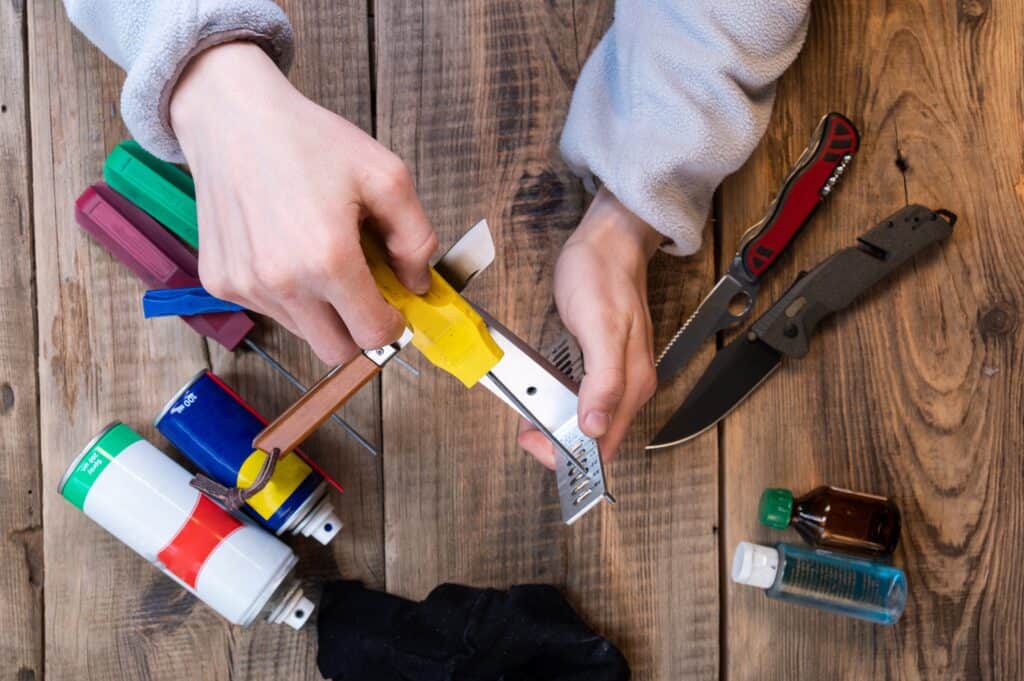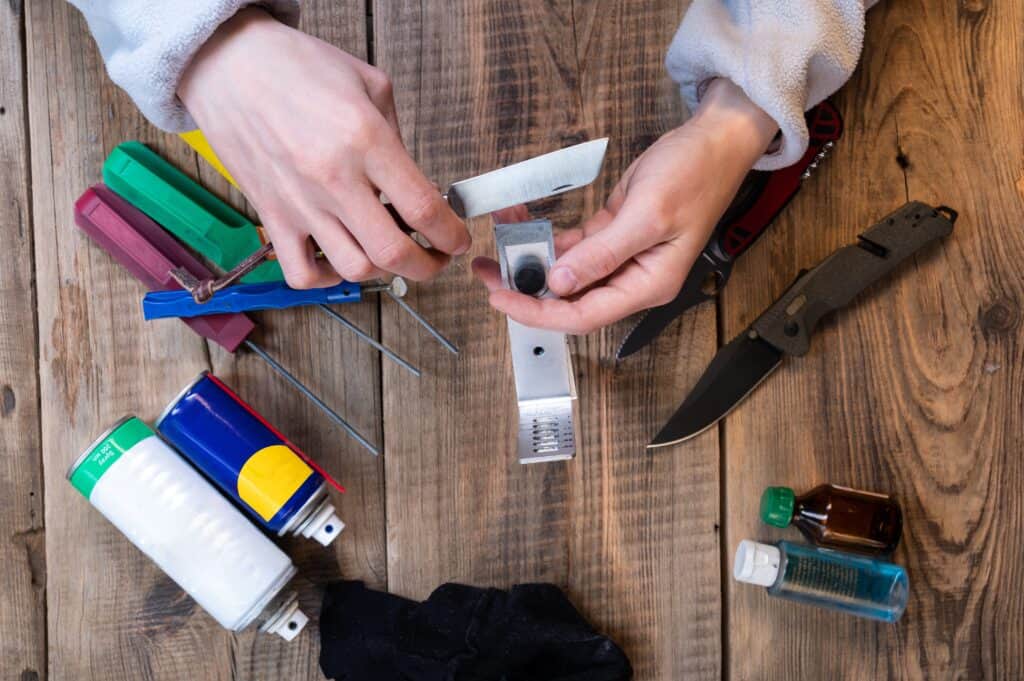As an Amazon Associate I earn from qualifying purchases.
A pocket knife is a versatile tool, and its usefulness largely depends on the sharpness and durability of its blade. One key aspect that influences a knife’s performance is its blade angle. The ideal blade angle ensures a balance between sharpness, resilience, and ease of use. Knowing the best angle for your pocket knife can help you maintain and enhance its cutting capabilities.
The blade angle is the total combined angle created by the edge profile, typically measured in degrees. Common blade angles for pocket knives range from 20 to 30 degrees per side, which balances performance and durability. Lower blade angles like 15 to 20 degrees provide an even sharper edge, ideal for slicing tasks, but tend to damage more easily.
Many pocket knife manufacturers, such as Kershaw and Spyderco, recommend a blade angle of around 20 degrees per side. This angle represents a middle-of-the-road approach suitable for a variety of tasks, from cutting food to handling tough outdoor projects. It is important to consider your specific needs and the tasks you’ll be performing with your pocket knife when determining the best blade angle for optimal performance.
Understanding Blade Angles
In this section, we will discuss blade angles and their importance in determining the performance and functionality of pocket knives.
Edge Bevels and Knife Types
The edge bevel is the part of the knife that tapers to form the cutting edge. Pocket knives generally have a double bevel, which means both sides of the blade are sharpened at an angle to create the cutting edge. The angle at which the knife is sharpened significantly affects its cutting performance and overall durability.
Different knife types have different edge angles depending on their intended use. A kitchen knife, for example, is typically sharpened at a 17 to 20-degree angle, while a hunting or camping knife may have an angle as low as 15 degrees.
Angle Ranges and Their Applications
Here is a general breakdown of the different angle ranges and their applications in pocket knives:
- 15-20 degrees: This is a low angle range, suitable for knives used for slicing, filleting, or delicate cutting tasks. Knives with these lower angles have a sharper edge but may be less durable due to less steel support behind the edge.
- 20-30 degrees: This range represents a balance between sharpness and durability and is commonly used for everyday carry knives. Knives sharpened at this angle can handle various tasks like cutting, chopping, and slicing.
- 30-40 degrees: Knives in this range have a more robust edge, making them suitable for heavy-duty cutting tasks such as chopping wood or batoning. The higher angle provides more steel reinforcement behind the edge, increasing its toughness and durability.
It is essential to consider both the type of knife you have and its intended use when determining the best angle to sharpen the blade. Maintaining the right blade angle can significantly impact a pocket knife’s cutting performance and longevity.
Best Blade Angles for Pocket Knives

Determining the best blade angle for your pocket knife depends on a balance between its intended use and the need for durability. Here, we will discuss two common angles for pocket knives: the 15-degree angle for precision cutting and the 20-degree angle for durability.
15 Degrees for Precision Cutting
The 15-degree angle is ideal for pocket knives that are designed for precision cutting tasks. This sharpening angle results in a thinner edge, making it perfect for tasks like slicing, carving, and other delicate work. However, this angle may be less durable when used to cut tougher materials, and the edge may be more prone to rolling or chipping during heavy-duty tasks.
- Ideal for: slicing, carving, precision cutting
- Strengths: sharper edge, increased cutting ability
- Weaknesses: less durability, prone to edge damage
20-Degree Angle for Durability
On the other hand, a 20-degree angle is recommended for pocket knives that prioritize durability. This angle is often used in kitchen knives and is considered optimal for cutting through tougher materials. While the edge is considered less sharp than the 15-degree angle, it is less prone to damage and requires less frequent sharpening.
- Ideal for: cutting tougher materials, prolonged use
- Strengths: increased durability, reduced edge damage
- Weaknesses: slightly reduced cutting ability
In summary, the 15-degree angle is best for precision cutting tasks, while the 20-degree angle offers better durability for more demanding use. It is essential to consider your pocket knife’s design and intended use when selecting the best sharpening angle. Ultimately, it’s all about finding the perfect balance between sharpness and durability to suit your needs.
Factors Affecting Blade Angles

There are several factors that influence the best blade angle for a pocket knife. This section will discuss these factors in detail, with an emphasis on blade thickness and material, knives with specialized uses, and sharpening techniques and abrasives.
Blade Thickness and Material
The thickness of the blade and the type of steel used can have a significant impact on the ideal sharpening angle. Thicker blades can withstand higher bevel angles, providing more durability for tasks like prying or chopping, while thinner blades might require a lower angle for better cutting performance. The blade steel can also affect the ideal angle, as some steels are harder and can hold a fine edge better than others. Moreover, harder steels may also contain more carbides, which can influence edge retention and rust resistance.
Knives with Specialized Uses
Certain pocket knives are designed for specific tasks and may require specialized bevel angles to perform optimally. For example, a tanto blade is intended for piercing through tough materials, so it might benefit from a higher angle that provides more strength to the tip. On the other hand, knives designed for filleting or slicing would perform better with a lower angle to allow for easier cutting.
Sharpening Techniques and Abrasives
The sharpening method and abrasives used can also affect the optimal blade angle. Some sharpening techniques, such as using a chisel grind, might require specific angles for the best results. Additionally, the choice of abrasive can influence edge retention and cutting performance. For instance, fine-grit stones can create a sharper edge, requiring a lower angle, while coarse-grit stones might necessitate a higher angle for durability.
- Lower angles (10-20 degrees): Suitable for thin blades, softer steels, and knives designed for slicing or filleting.
- Higher angles (20-30 degrees): Suitable for thicker blades, harder steels, and knives intended for prying or chopping tasks like a pry bar.
In conclusion, various factors influence the best blade angle for a pocket knife. Carefully consider the blade thickness and material, the intended use of the knife, and the chosen sharpening technique and abrasive to determine the optimal angle for your pocket knife.
Choosing the Right Pocket Knife
Assessing Blade Shape and Length
When choosing the right pocket knife, you should first consider the blade shape and length. Different types of blades cater to various purposes. For example, a clip point blade is suitable for general-purpose use and works well for hunting knives. On the other hand, a single bevel blade works well for straight razors and Japanese knives.
Always check the blade length according to your requirements, as different tasks may require different lengths. For instance, shorter blades (around 2-3 inches) are suitable for everyday carry and ease of ownership, while longer blades (3-4 inches) may be needed for more heavy-duty tasks like hunting and camping.
The type of steel used in the blade, such as carbon steel, and the steel hardness have a significant impact on the knife’s performance. Pay attention to these factors and heat treatment processes used, which can affect edge retention and overall durability.
Examining Handle and Opening Mechanisms
Another critical aspect of choosing the right pocket knife is examining the handle and opening mechanisms. A comfortable, secure grip is essential, especially when doing more intensive tasks. Handles made from materials like G-10 or Micarta can provide good grip and durability. Brands like Spyderco are known for their high-quality handles and designs.
Pocket knives come with various opening mechanisms like manual open, assisted open, and automatic open. Manual opening knives require two hands for opening, but they’re more straightforward and reliable. Assisted opening knives, on the other hand, allow easy one-handed opening with a spring mechanism. Automatic knives are quick and convenient but are subject to more legal restrictions in certain places.
When it comes to sharpening your pocket knife, various methods can be employed. The use of a whetstone or water stones can provide excellent results, especially for carbon steel blades. Freehand sharpening, while challenging, can also provide an unmatched level of control and precision. Alternatively, sharpening systems that feature carbides or diamond abrasives can help maintain the blade’s edge without much hassle.
In conclusion, choosing the right pocket knife depends on factors like blade shape, length, steel type, handle material, and opening mechanisms. By considering these aspects and the intended use of the pocket knife, you can find the best option suited to your needs.
Remember: always adhere to local laws and regulations regarding pocket knife ownership and use. Happy shopping!
Conclusion
In summary, the ideal sharpening angle for a pocket knife largely depends on its intended use and personal preferences. As described earlier, knife sharpening angles between 17 and 22 degrees are the most common for pocket knives, providing a balance between durability and sharpness.
If you prioritize sharpness and precision, a lower angle of around 15-20 degrees should suit your needs. Be aware, however, that knives sharpened at lower angles may require more frequent maintenance as they are more prone to edge damage.
On the other hand, if durability is key, consider sharpening your pocket knife at a slightly higher angle of 20-30 degrees per side, which results in 40-60 degrees inclusive edge bevels. This provides a more robust and long-lasting edge that is capable of handling various tasks but may not be as sharp as you’d expect from lower angles.
Remember that blade thickness and grind can also impact the ease of sharpening at certain angles, as thicker blades may require more material removal for lower edge angles. Taking these factors into account, choose the best angle for your pocket knife based on your specific needs and ideal balance between performance, durability, and maintenance.
Ultimately, finding the ideal blade angle for your pocket knife is a process of experimentation and adaptation based on your day-to-day usage. Keep your knife sharp and well-maintained, and it will serve you well in various tasks and situations.
Do Sheepsfoot Blades Have A Purpose? (Cuz They’re Ugly…)
Spetsnaz Machetes – Blades Of The Russian Special Forces
What Is The Actual Purpose Of A Spear Point Knife Blade?
CRKT CEO Review – Coolest, Most Worthless Knife Ever?
How Sharp Is A Scalpel? (Is It Sharper Than A Razor?)
Can You Shave With A Knife? (Yes, Here’s How)
As an Amazon Associate I earn from qualifying purchases.







